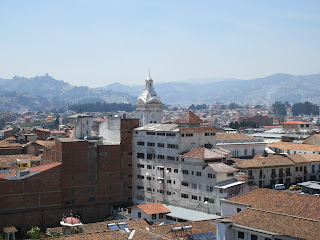Chan Chan and Los Huancas de los Moches, Temples of the Sun and the Moon, 25th - 27th November
We left the beach resort and drove through the village for the next few days to fead for Lima. There was a shrub desert with nodding donkeys and pipes running everywhere connecting the various oil wells.
Where there was water for irrigation there were fields and trees but these ended abruptly where the pipes and canals finished and as we went further south, the amount of natural vegetation diminished to nothing but sand and rock.
We had a hostel overlooking the sea near Trujillo and another great sunset with waves washing over the sandy beach.
We left the beach resort and drove through the village for the next few days to fead for Lima. There was a shrub desert with nodding donkeys and pipes running everywhere connecting the various oil wells.
Where there was water for irrigation there were fields and trees but these ended abruptly where the pipes and canals finished and as we went further south, the amount of natural vegetation diminished to nothing but sand and rock.
Endless dry desert.
Outside a small town we did a bush camp, nothing remarkable about the location but the sunset was particularly spectacular.
After another day on the road, in the afternoon we stopped at Chan Chan, a mud built city with several walled royal enclosures. It is significant archaeologically but there is not much to see.
We had a hostel overlooking the sea near Trujillo and another great sunset with waves washing over the sandy beach.
In the morning we stopped at the Huancas del Moches, also called the Temples of the Sun and the Moon and in contrast to Chan Chan there was a lot more to see and the guide was much more informative. It had been covered by the sand and also each successive alteration was a larger temple built over the existing temple thus preserving five different architectural styles.
Shane and Stu bombing my photo.
A view over diggings in the old city between the Temple of the Moon and the Temple of the Sun which used it is estimated 140 million mud bricks.
t
The five different levels of development shown in the walls of the temple facing the old city.
After visiting the temples and the associated museum dedicated to the Moches civilisation which built the temples it was back along the main road down the coast through the desert. I always thought of Peru as a country with jungle and mountains which it has in abundance in the interior but the whole coastal strip is desert.
Sand dunes marching their way across a hillside.
We drove off the road and found a secluded place for a bush camp behind a hill out of sight of the road in the vast desert. And then it was the final section of road to reach Lima to stay there for a few days.
Shane and Stu bombing my photo.
A detail of some of the decoration.
A detail of such of the mud bricks that were built over an existing frieze in a later expansion of the temple.A view over diggings in the old city between the Temple of the Moon and the Temple of the Sun which used it is estimated 140 million mud bricks.
t
The five different levels of development shown in the walls of the temple facing the old city.
After visiting the temples and the associated museum dedicated to the Moches civilisation which built the temples it was back along the main road down the coast through the desert. I always thought of Peru as a country with jungle and mountains which it has in abundance in the interior but the whole coastal strip is desert.
Sand dunes marching their way across a hillside.
We drove off the road and found a secluded place for a bush camp behind a hill out of sight of the road in the vast desert. And then it was the final section of road to reach Lima to stay there for a few days.








































































